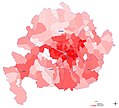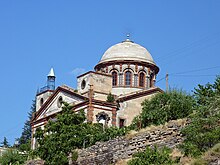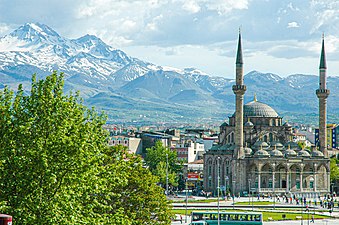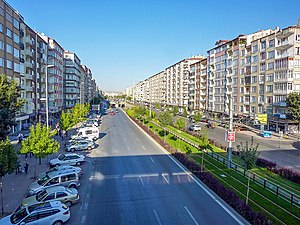Kayseri
| Kayseri | ||||
|
||||
 City center |
||||
| Basic data | ||||
|---|---|---|---|---|
| Province (il) : | Kayseri | |||
| Coordinates : | 38 ° 44 ' N , 35 ° 29' E | |||
| Height : | 1054 m | |||
| Surface: | 2,150 km² | |||
| Residents : | 1,322,376 (2014) | |||
| Population density : | 615 inhabitants per km² | |||
| Telephone code : | (+90) 352 | |||
| Postal code : | 38,000 | |||
| License plate : | 38 | |||
| Structure and administration (as of 2019) | ||||
| Mayor : | Memduh Büyükkılıç ( AKP ) | |||
| Website: | ||||
Kayseri ( Latin Caesarea , named in honor of the Roman Emperor Tiberius ; Greek Καισάρεια Caesarea , Armenian Կեսարիա Kesaria ), previously Mazaca ( Armenian Մաժաք Mazhak ' , Greek Μαζάκα ) or Eusebeia ( Greek Ἐυσεβεία ), is the capital of the province of Kayseri in Cappadocia in of Turkey . In 2000, the city still had 536,392 inhabitants, today's Büyükşehir Belediyesi (German roughly large city municipality ), which is congruent with the province of Kayseri , has 1,358,980 inhabitants (as of 2016).
Kayseri is located at 1054 m at the foot of the extinct volcano Erciyes (3916 m), which was responsible for the tufa layers in Cappadocia with its eruptions .
history
The location of today's city was interspersed with salt lakes and swamps until the 4th century, some of which were only drained in the last century. Since Hittite times the place was called Mazaka . In the Hellenistic period, the kings of Cappadocia and Eusebeia , as Mazaka was also called at that time, resided here , and together with Tyana in the south , they formed one of the two country centers.
According to Strabo , the city was still unfortified and surrounded by robbery tribes in his day. The surrounding land was barren, sandy and stony, the city itself "waterless". Numerous “fire pits” seem to have survived from the volcanic activity around the Erciyes . The supply of wood over the slopes of the volcano mountain was therefore difficult. In the plain around the city flowed the swampy river Melas ( Greek Μέλας ), today's Karasu Çayı (both names mean "black river"), a tributary of the Delice Çayı , called Cappadox in ancient times and in turn a tributary of the Kızılırmak or Halys. By damming the Melas at its mouth, the Cappadocian king Ariarathes created a "sea-like lake" with a few islands. But the break of the dam caused a flood of mud on the entire lower reaches of the Halys, especially among the Galatians of Phrygia , who then demanded compensation.
Around 77 BC The city was captured for the second time by the Armenian great king Tigranes II. The ruler once again had numerous residents deported to his new capital, Tigranokerta in northern Mesopotamia . Only after the Roman conquest of this place under Pompey (69 BC) was the resettled population able to return. With the death of its last king Archelaus , Cappadocia lost its independence in 17 AD and was converted into the Roman province of Cappadocia under Emperor Tiberius . Mazaka-Eusebeia now served as the provincial capital and was given the name Caesarea (Greek Kaisáreia ). After the partition of Cappadocia under Emperor Valens , Caesarea was the capital of Cappadocia great .
According to Christian tradition, Christianity caught on early on among the city's citizens ( 1 Petr 1.1 EU ). At the beginning of the 3rd century Caesarea was a center of Christian theological education. Caesarea experienced its heyday in the 4th century. The social works ( hospitals , old people's homes , feeding the poor ) that Basil of Caesarea established there in the second half of the fourth century were famous in antiquity. The new settlement grew rapidly while the old quarters gradually fell into disrepair (remains can still be found today).
After troubled times, the city was lost to the Byzantine Empire around 1077 . In 1082 it came into the possession of the Danischmenden , during the 1st Crusade (1096-1099) temporarily also in the possession of the Crusaders under Gottfried von Bouillon . In the 12th and 13th centuries it was temporarily the residence of the Seljuks and experienced a second heyday. After further conquests, it was ruled by the Mongols . The subsequently Ottoman Kayseri became Mongolian again under Timur in 1401 , and Ottoman again from 1468. The following long period of peace enabled an upward development as a provincial town.
Around 1900 the new town was built north of the citadel. Many buildings from this period have survived. Here you will also find the oldest psychiatric clinic of modern times, in which therapy was carried out with the help of music - a treatment method that was revolutionary at the time. In the city center there are the walls of the fortress and several Seljuk mosques of the Ulu Cami type (centerless hall of columns).
On December 17, 2016, according to the Doğan Haber Ajansı news agency , there was an explosion at the entrance of Erciyes University. The detonation hit a passing public bus carrying soldiers from the Turkish armed forces . According to the military, there were 13 dead and several injured. Turkey’s Vice Prime Minister Veysi Kaynak told NTV that “insidious interest groups” had targeted members of the Kayseri Air Force Brigade. Just a week earlier, 44 people had been killed in bomb attacks in Istanbul .
population
According to the Big City Act of 2012, the provincial border is the city border. As a result, the boroughs are now also part of the city. The inner city, which consists of the districts of Kocasinan , Melikgazi and Talas, has around 1 million inhabitants.
| year | population | change |
|---|---|---|
| 1965 | 191,221 | |
| 1970 | 236.824 | 23.85% |
| 1975 | 295,582 | 24.81% |
| 1980 | 380,352 | 28.68% |
| 1985 | 488,556 | 28.45% |
| 1990 | 604.072 | 23.64% |
| 2000 | 732.354 | 21.24% |
| 2007 | 895.253 | 22.24% |
| 2008 | 1,001,449 | 11.86% |
| 2009 | 1,027,279 | 2.58% |
| 2010 | 1,064,164 | 3.59% |
| 2011 | 1,090,530 | 2.48% |
| 2012 | 1,116,393 | 2.38% |
| 2013 | 1,295,355 | 16% |
| 2014 | 1,322,376 | 2.09% |
| 2015 | 1,341,056 | 1.77% |
| 2016 | 1,358,980 | 1.82% |
Residents by city district
| Borough | Residents |
|---|---|
| Akkışla | 6.234 |
| Bünyan | 27,944 |
| Develi | 64,550 |
| Felahiye | 6,451 |
| Hacılar | 12,290 |
| İncesu | 24,405 |
| Kocasinan | 384.203 |
| Melikgazi | 537.035 |
| Özvatan | 3,934 |
| Pınarbaşı | 25,293 |
| Sarıoğlan | 14,521 |
| Sarız | 10,529 |
| Talas | 128,414 |
| Tomarza | 24,131 |
| Yahyalı | 36,578 |
| Yeşilhisar | 15,864 |
Lord Mayor
With date and election result
|
|
|
|
kitchen
The city is famous for its air-dried beef ham ( pastırma ), its garlic sausage sucuk and the filled dumplings manti .
Education and Research
Kayseri is home to three universities with 52,000 students and 5,000 graduates. The Abdullah Gül University started operations with 121 students in the 2013/14 academic year. It has three faculties and eight departments. The Erciyes University is the largest, occupying the 17th place in Turkey with about 29,000 students. It was founded in 1978 southeast of Kayseri and previously had its name before it was named after Mount Erciyes in 1982. It is divided into 16 departments, 70 subjects, seven vocational schools, seven institutes and 19 research areas. 2020 academics are tasked with imparting knowledge here. The foundation stone for the establishment of this university was laid in 1968, where a medical faculty named after Gevher Nesibe was opened. Gevher Nesibe was the daughter of the Seljuk Sultan Kılıç Arslan II , who died of tuberculosis in Kayseri in 1204 .
Melikşah University, which was built in 2008 and is located southeast in the Talas district, is divided into four faculties with twelve subjects, two institutes that employ a total of 110 lecturers. There is space for 1311 students every year. The departments are architecture , engineering , literature and law . It takes its name from the Seljuk Sultan Melikşah , who ruled the Seljuk Empire from 1072 to 1092. Nuh Yaci Yazgan University, located northwest in the Erkilet district, has four faculties and six subjects, seven vocational schools and two institutes and employs 22 lecturers. Since 2009 there is space for 100 students every year. Nuh Yaci Yazgan was a charitable businessman and politician who died in Kayseri in 1947.
80% - 90% of the students are selected annually by the Yükseköğretim Kurulu (YÖK) , a kind of university council, according to the Öğrenci Seçme Sınavı principle ( university entrance examination). It is based in Ankara and was founded in 1982 after the military coup to depoliticize the universities. The remaining space is allocated to foreign students.
269,076 students attend one of the 1,163 schools or institutions. Kayseri has a total of 14,798 lecturers. Thus there are 28 pupils in elementary and secondary schools and 30 pupils in vocational schools for one assistant professor. The city has 9640 classrooms.
Worth seeing
There are several attractions in the area, among others
- The Armenian Church of Saint Gregory the Illuminator
- The excavations of Kültepe (the Bronze Age Kaneš)
- The Hittite rock relief of Fıraktın
- The Hittite rock relief of Hanyeri
- Mimarsinan, the birthplace of the architect Sinan
- In the village of Gezi an underground city
- The Soğanlı Valley with numerous cave churches
- The underground city at the foot of Ali Dağı in the Talas district
- The Greek Orthodox Panaghia Church in Talas , which has been converted into a mosque
- The Kapuzbaşı waterfalls in the border area with Adana
- The Sultan Sazlığı National Park to the southeast
- Lake Tuzla, which is also used for salt production
- The Yamula Reservoir
- Rock caves in the Erkilet district
Expansion of the Erciyes mountain into a winter sports resort
The mountain is to be made accessible for winter sports with investments of € 300 million. Several ski slopes and a small artificial lake will be built at the foot of the Erciyes Dağı . After the completion of the Erciyes master plan, the ski slope will be 160 km long. There are also 5,000 overnight accommodations. The work was completed in early 2013. There should also be a fun park for freestyle snowboarders and skiers. The city has ambitions to make the ski area the largest in Turkey and thus primarily to attract European winter sports enthusiasts.
Afforestation of the Ali mountain
In order to make the city more attractive, the Ali Dağı was reforested. The total area covers 550 hectares. First, the front of the mountain (210 hectares) visible from the city was planted. By the end of 2007, 180,000 sprouts had been planted and watered here. A total of 800,000 trees were planted.
climate
Due to its location in the area of the continental climate, Kayseri has warm summers and cold winters. The warm days start in April and last until October. Maximum temperatures are reached between July and August. The weather is then very warm and dry. The months of April and May are known for their rainy season.
| Kayseri, Kocasinan (1053 m) | ||||||||||||||||||||||||||||||||||||||||||||||||
|---|---|---|---|---|---|---|---|---|---|---|---|---|---|---|---|---|---|---|---|---|---|---|---|---|---|---|---|---|---|---|---|---|---|---|---|---|---|---|---|---|---|---|---|---|---|---|---|---|
| Climate diagram | ||||||||||||||||||||||||||||||||||||||||||||||||
| ||||||||||||||||||||||||||||||||||||||||||||||||
|
Monthly Average Temperatures and Precipitation for Kayseri, Kocasinan (1053 m)
|
||||||||||||||||||||||||||||||||||||||||||||||||||||||||||||||||||||||||||||||||||||||||||||||||||||||||||||||||||||||||||||||||||||||||||||||||||||||||||||||||||||||||||||||||||||
media
| Television channels |
|
|
| Radios |
|
|
|
|
|
| Newspapers |
|
|
Sports
The football club Kayserispor plays in the Turkish Süper Lig . It was founded in 1966 and is colored red and yellow. Kayserispor has been champions in the second division several times. The breakthrough came in the 2000/2001 season: Erciyesspor (the then name of the club) survived the play-offs and rose to the top division for the first time. In order to represent the name of the city more obviously, the club also took over the name Kayserispor from its local competitor, who in turn continued to play as Kayseri Erciyesspor , i.e. with the discarded name of the newcomer. The club won the Turkish Cup ( Fortis Türkiye Kupasi ) in the 2007/2008 season .
The club Kayseri Erciyesspor managed to move up from the amateur league to the first division within a few years, then to the final of the Turkish Cup and to play in the UEFA CUP. The club plays in the second division in the 2008/09 season. In the 2012/13 season they made it to the Süperlig. From the 2013/14 season, two teams from Kayseri will be represented in the Süperlig.
The basketball team Kayseri Kaski Spor Kulübü was founded in 1986 under the name TED Kayseri Koleji Kulübü. 2005–2006 he was promoted to the first division and was in 9th place at the time. In 2009-2010 he was taken over by Panküp Şeker Spor. Due to various problems at Kayseri Şeker Fabrikası, the club closed. At the instigation of Mayor Mehmet Özhaseki, an extraordinary meeting was called on August 24, 2011 and the water utility Kaski was given the task of ensuring the regular operation of this basketball team. Since her rise, she has been playing both nationally and internationally. The venue for the games is the Kadir Has Congress and Sports Center, located north near Erkilet Airport, with a capacity of 7,500. It was the venue for various international matches at the 2010 Basketball World Cup.
Kadir Has Stadium and Ataturk Sports Center
The stadium (Kadir Has Şehir Stadyumu) can accommodate 32,864 spectators. It was completed in February 2009 and meets the UEFA criteria. The costs for the new building amounted to 56,983,000 TL (approx. € 30 million). International matches for the Turkish national team also take place in this stadium.
The recently built Ataturk Sports Building (Ataturk Spor Kompleksi) includes a swimming pool, a sports salon with a capacity of 1,000 people, a grass soccer field with 1,500 spectators, an athletics track and three tennis courts. Both the swimming pool and the track meet Olympic criteria.
Stadium data:
| total area | 196,000 m² |
| spectator | 32,864 |
| 16 person boxes | 24 |
| 23 person boxes | 2 |
| 80 people café | 1 |
| 100 person restaurant | 1 |
| Green space | 26,867 m² |
| shopping mall | 5000 m² |
| Fan article shop | 1000 m² |
| Administrative and UEFA offices | 5000 m² |
| parking spot | 1785 cars |
Economy and Transport
Kayseri is one of the most important industrial and commercial centers in the country, the city has the largest industrial area in Turkey. 80 percent of Turkish furniture production comes from Kayseri, but doors, metals, household goods and food are also manufactured in the city. Kayseri is a transport hub in Turkey and has an international airport ( Erkilet Airport ) and central railway connections. The connections to other cities are well developed with highways and multi-lane country roads.
Erkilet Airport
The Kayseri airport was rebuilt between 2005 and 2010 so that now the capacity has increased to 3 million for domestic flights (2.5 million for international flights). The airport area now measures 11,000 m². The area usable by passengers is now 4000 m².
KayseRay tram
In order to reduce motorized traffic in the city center, a first tram line was built in Kayseri and opened in August 2009. An extension of the first line went into operation in February 2014, as did a section of a second line. As a result, the tram network in Kayseri has a length of 30.9 km since February 2014, with 42 stops. Further sections of the route are under construction.
Shopping centers
The Forum Kayseri, which opened in December 2011 and was built on the site of the old stadium, has four floors with a total area of 65,000 m². It is currently the largest shopping center in the city.
| Surname | Area (m²) | shops | opening | location | monthly Number of visitors |
|---|---|---|---|---|---|
| Forum Kayseri | 65,000 | 190 | 2011 | City center | |
| Başyazıcıoğlu | 55,000 | 70 | 2011 | east | |
| Optimal | 50,000 | 22nd | 2009 | east | |
| Meysu | 50,000 | 22nd | 2011 | west | |
| Ipeksaray | 38,000 | 50 | 2006 | east | 250,000 |
| Kayseri Park | 27,000 | 120 | 2006 | east | 680,000 |
Town twinning
- Krefeld , Germany
- Yongin , South Korea
- Mostar , Bosnia and Herzegovina
- Homs , Syria
- Nalchik , Kabardino-Balkaria (Russia)
- Regional Association Saarbrücken , Germany
Personalities
On October 29, 1950, the 11th President of Turkey, Abdullah Gül, was born. The industrialist and philanthropist Sakıp Sabancı was born near Kayseri in 1933. He built up various companies across the country and moved to Adana at a young age to find work . Other industrialists such as Halit Narin (Narin Tekstil) , the entrepreneur Kadir Has (Has Holding) , İzzet Özilhan ( Anadolu Grubu ) , Hacı Boydak ( Boydak Holding-İstikbal ) or Necati Kurmel ( Saray Halı ) also come from this city.
- Kazım Abacı (* 1965), politician
- Hulusi Akar (* 1952), politician (AKP)
- Basil of Caesarea (≈330–379), important doctor of the church, bishop and saint
- Sinan Bolat (* 1988), soccer goalkeeper
- Umut Bulut (* 1983), football player
- Oğuz Büyükberber (* 1970), jazz musician
- Atilla Engin (1946–2019), musician, band leader and composer
- Nebahat Güçlü (* 1965), German-Turkish politician (SPD)
- Sarkis Kalfa († late. 1740), Armenian architect
- Teodor Kasap (1835-1897), editor
- Dikran Khan Kelekian (1868–1951), Armenian-American art dealer and art collector
- Diran Kelekian (1862–1915), Armenian journalist
- Hagop Kevorkian (1872–1962), American art collector and patron
- Kenan Kocak (* 1981), soccer player and coach
- Lütfi (1833–1898), Armenian poet and journalist
- Erdal Merdan (1949–2010), theater and radio play author, actor and director who worked in Germany
- Mihran Nakkashian (1850–1944), Armenian editor and publicist
- Celil Oker (1952-2019), writer
- Eren Önsöz (* 1972), radio writer and filmmaker
- Sinan (≈1490–1588), Ottoman architect
- Ali Turan (born 1983), football player
- Hacı-Halil Uslucan (* 1965), German psychologist and sociologist
- Sakıp Sabancı (1933-2004), entrepreneur
- Menekşe Toprak (* 1970), German-Turkish author, literary translator and cultural journalist
- Sarkis Torossian (1891–1954), Armenian commander in the Ottoman army
- Mehmet Yıldız (* 1977), German-Turkish politician (Left Party)
gallery
Mustafa Kemal Ataturk's villa
Web links
- Official website of the city (Turkish and English)
- Background material from the European Stability Initiative (ESI) on Kayseri
- Report of the European Stability Initiative (ESI): Islamic Calvinists: Change and Conservatism in Central Anatolia
- Kayseri's kitchen
- Governorship
- Ermeni ve Rum kältür varlklaryla Kayseri = Kayseri with its Armenian and Greek cultural heritage. Ed. Altug Ylmaz. Hrant Dink Vakf Yaynlar, Istanbul 2016, ISBN 605-66011-4-5 ; ISBN 978-605-66011-4-9 ; Text in Turkish and English.
Individual evidence
- ^ Turkish Institute for Statistics ( Memento of February 9, 2015 in the Internet Archive ), accessed on February 9, 2015
- ↑ Archived copy ( Memento of the original dated December 29, 2011 in the Internet Archive ) Info: The archive link was automatically inserted and not yet checked. Please check the original and archive link according to the instructions and then remove this notice. World Gazetteer
- ↑ Strabon, Geographie 12,2,6 (Casaubonus, p. 538), quoted from the translation by A. Forbiger, Marix, Wiesbaden 2005, p. 777.
- ↑ Strabon, Geographie 12,2,7 (Casaubonus, p. 538 f.), Quoted from the translation by A. Forbiger, Marix, Wiesbaden 2005, p. 777 f.
- ↑ Emre Peker: Turkey Bus Blast Kills 13 Soldiers, Leaves Dozens Injured. The Wall Street Journal, December 17, 2016, accessed December 17, 2016 .
- ^ Turkish Institute for Statistics ( Memento of February 9, 2015 in the Internet Archive ), accessed on February 9, 2015
- ^ Turkish Institute for Statistics ( Memento of February 9, 2015 in the Internet Archive ), accessed on February 9, 2015
- ^ Erciyes University , accessed August 28, 2012
- ↑ Melikşah University ( Memento of the original from July 19, 2016 in the Internet Archive ) Info: The archive link was inserted automatically and has not yet been checked. Please check the original and archive link according to the instructions and then remove this notice. , accessed on August 28, 2012
- ↑ Nuh Yaci Yazgan University , accessed on August 28, 2012
- ^ Ministry of Culture, Kayseri branch , accessed on August 28, 2012
- ↑ Gonca Buyukmihci, Zuhal Ozcan, Hale Kozlu: Three Greek Orthodox Churches from Kayseri, Turkey, and the Ethnic Composition of Ottoman Society . In: Transactions of the Ancient Monuments Society 51 (2007) 57-77, here 66-70.
- ↑ kayserierciyes.com.tr , accessed May 17, 2013
- ↑ Kayseri: Gateway to Cappadocia . Travel EXCLUSIV magazine website, accessed December 9, 2014.
- ^ Kayseri Kaski Spor , accessed August 29, 2012
- ↑ a b c d e f Kayseri website ( Memento of the original from August 15, 2012 in the Internet Archive ) Info: The archive link was automatically inserted and not yet checked. Please check the original and archive link according to the instructions and then remove this notice. , accessed September 6, 2012
- ↑ Sister city Kayseri on krefeld.de Accessed on July 30, 2020





























